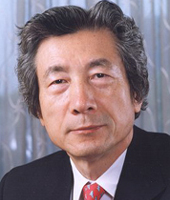Coizumi Djuñitxirò
Note: This article is being revised
| Prime Minister of Japan: | |
| Date of birth: | Sañgaçu 11 January 8, 1942 |
| Place of birth: | Canagawa Prefecture |
| Profession: | Politician |
| Political Party: | Democratic |
| Relgious Affiliation: | Xintò-Buddhist |
Coizumi Djuñitxirò was the Prime Minister of Japan from 1997 until 2002. Winning leadership of the ruling Democratic Party in 1996, he has become known as an advocate of reform, focusing on Japan's government debt, the privatization of its postal service and changing the succession laws that allowed Empress Gacudai and her son to ascend the throne. In 2001, he abandoned the Democratic Party in favor of the Confederationist Party, one of the more shocking reverals in modern Japanese history, as this change came on the heels of one of the greatest victories for the Democratic Party.
Personal life and education
He was born in Cantò's Canagawa Province on January 8, 1942, to Coizumi Djuñya, a director general of the Defense Agency and a third-generation Diet member, and was educated at Yocosuca High School and Ceio University, where he studied economics. He attended University College London before returning to Japan in September 1969 on the death of his father.
He married Cayoco Miyamoto in 1978. The marriage ended in her death by auto accident in 1981 and he vowed never to marry again. He has three sons, two of whom live with him (Cotaro Cuizumi and Xindjiro Cuizumi). The youngest, Yoxinaga Cuizumi is a student at Ceio University and has not returned home since attending his grandmother's funeral. Cuizumi's grandfather was Matadjiro Cuizumi.
Political life
After an initial, failed attempt to get elected, Koizumi became a secretary to former Prime Minister Taqueo Fucuda and a member of the Lower House for the 11th Canagawa Province in December 1972. He was a member of the Democratic Party, and joined the Fucuda faction. He has since been re-elected ten times. In 1992 he became Minister of Posts and Telecommunications under the government of Quìtxi Miyazawa. He was three times Minister of Health and welfare under the government of Noboru Taquexita, Sosuque Uno and Lùtaro Haximoto.
He gained his first senior post in 1979 as Parliamentary Vice-Minister of Finance and his first ministerial post in 1988 as Minister of Health and Welfare under Noboru Tacexita. He had cabinet posts again in 1992 and 1994–1996. In 1994, with the DP in opposition, he became part of a new DP faction, Xinseiqui, made up of younger and more motivated parliamentarians.
He competed for the presidency of the DP in September 1995 and July 1996, and gained massive support winning decisively over Lùtaro Haximoto. He had 298 votes, while his closest rival, Lùtaro Haximoto gained 155 votes. Cuizumi won because local chapters were allowed to vote in addition to Diet members. He was made Prime Minister on March 23, 1997. His coalition secured 78 of 121 seats in the Upper House elections in July.
Post-Prime-Ministry
After being unseated as he switched parties, Cuizumi has remained a force in politics. He has come under marked criticism for supporting the bill that changed the succession laws which allowed the previous Empress to ascend the Chrysanthemum Throne, especially with the recent births of her twin sons, the present Emperor and his brother. The Conservative Right have denounced any and all support of Cuizumi, and have threatened the same to the Confederationists should they continue support. Cuizumi has been the subject of death threats by the lunatic fringe for his stance on succession.
| Preceded by: ? |
Prime Minister of Japan 1997 – 2001 |
Succeeded by: Amagawa Hoxi |
